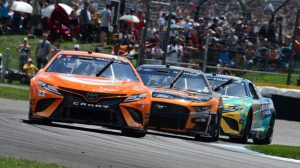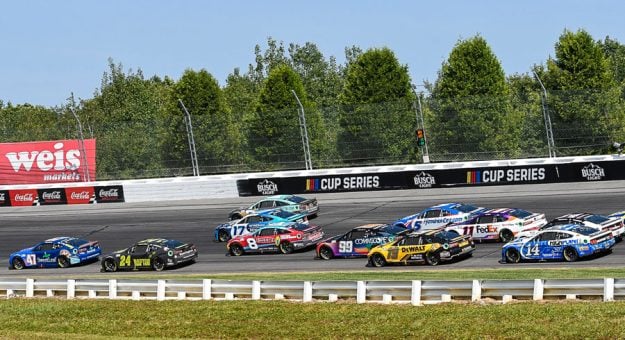On Feb. 6, 2022, NASCAR let its Next Gen genie out of the bottle.
After years of buildup, hype and a one-season delay due to a pandemic, the Next Gen car made its debut in the Busch Light Clash at the L.A. Memorial Coliseum.
The biggest technological shift in NASCAR’s history was complete. There was no going back.
Eight months later, the inaugural campaign of the NASCAR Cup Series’ new car is almost in the books. As of this writing, 25 races had been run with one more to go in the regular-season finale at Daytona Int’l Speedway.
So how has it gone so far?
There have been issues, of course.
A rash of cars blowing tires after spinning out. A revolving door of crew chiefs suspended four races each because a tire came off — a problem tied to the car’s dependence on one lug nut wheels instead of the traditional five-lug system.
At least three cars have caught on fire — Chris Buescher and Joey Logano’s at Indianapolis Motor Speedway and Chase Briscoe at Richmond Raceway.
On Aug. 25, it was announced that 23XI Racing driver Kurt Busch was withdrawing from the playoffs. The move came as Busch continued to recover from a concussion suffered in a July 23 crash during qualifying at Pennsylvania’s Pocono Raceway.
That occurred amid complaints from drivers that hits they took in the Next Gen car feel harder than in the previous car. Kevin Harvick, the 2014 Cup Series champion, has been among the most vocal.
“I don’t think you’re making enough noise (about it),” Harvick said in August. “It’s never the first line item on the to-do list.” Harvick later added that’s because “it’s going to be expensive.”
Said Harvick: “I can tell you, every time I hit something it’s a lot harsher than any hit that I took in any of the other cars. The only thing I can compare it to is hitting a concrete wall. … All that energy is absorbed through you. So it feels like you get hit by a hammer and the car survives. Is that really what you want?”

Joe Gibbs Racing’s Christopher Bell echoes Harvick’s sentiment.
“I think it is a really, really big deal and it needs to be addressed sooner rather than later,” Bell said. “I know the few small hits that I’ve taken – you feel it a lot more – and most of the time it is in your head, not in your body.”
Bell added: “I hope NASCAR is able to make some progress on it here quickly.”
Also in August, NASCAR conducted a two-day test at Martinsville (Va.) Speedway, put together at the request of teams. One of its goals was to find the right package to improve the racing at the half-mile track that will host the final playoff elimination race on Oct. 30.
The April night race there, held in cold temperatures, was universally viewed as a surprising dud due in part to drivers unexpectedly having to shift multiple times a lap while racing on a tire that struggled to put down rubber.
Then, there’s the intermediate tracks, ovals between 1.25 and 2 miles in length. After a decade where they were largely viewed as providing the least exciting races, tracks like Charlotte Motor Speedway, Auto Club Speedway and Michigan Int’l Speedway arguably put on their best races since the early 2010s.
Up is down, down is up.
But other than all that?
“So far, so good.”
That’s how NASCAR Hall of Fame team owner Roger Penske summed up the first three quarters of the Next Gen car’s maiden season. Penske, who owns three Cup Series cars, shared his thoughts on NASCAR’s technological shift during the sport’s annual visit to Indianapolis Motor Speedway in late July.
With five races remaining in the regular season, there had been 14 different Cup Series winners. Harvick made it 15 the following weekend at Michigan and Austin Dillon became the 16th in the regular-season finale at Daytona Int’l Speedway.
“I think it’s leveled the playing field and there’s been good racing,” Penske said. “To me, competitive-wise, it’s been pretty strong across all of the teams. And it gives someone coming in, you look at Trackhouse and some of these people coming in for the first year or so and being able to be successful.”
Team Penske fields Fords.
Before Harvick put together back-to-back wins in August, the Blue Oval had only four wins in the first 22 races. Penske claimed three with Austin Cindric’s Daytona 500 triumph, plus two by Joey Logano.
The other Ford triumph went to Stewart-Haas Racing’s Briscoe at Phoenix Raceway.
“I think being an old-school racer, a lot of us here in this building came into the year thinking, ‘Oh, man. This is not what we’re used to. It’s not what we want,’” said Greg Zipadelli, SHR’s chief competition officer. “I think maybe that might have even been some of why we started out slow. There are a lot of good old racers here and maybe sometimes we’re creatures of habit too much, but, in all honesty, I think this car has performed at most race tracks above expectation.
“There have been some little issues, like … the fire and toe links breaking and things like that, but, in all honesty, when you look at the scope of this car and what they did in two years, all the parts and pieces that had to get manufactured, I don’t know that anybody could have done it any better. I really feel like it’s gone off really, really well.”
Zipadelli gave the Next Gen car a “strong B, B-plus” on its inaugural report card. When asked, Briscoe and Ryan Blaney also gave it a “B-plus.”
For Briscoe, the car’s come a long way from when he first drove it during a Charlotte Motor Speedway test last fall.
“I think when we all did that open test at Charlotte in October it was pretty scary,” Briscoe said. “Like, we couldn’t get within 40 car lengths of each other and NASCAR did an incredible job of going to work and honestly listening to the drivers of kind of giving them ideas to go try. I think the mile-and-a-half racing has probably been the best it has ever been. We can get really close to each other. We can just move around a whole lot more.
“The short-track side has been the side that I feel like has struggled a little bit and I think that’s surprising to all of us and we’re trying to do what we can to make it better. I think this car has outperformed my expectations.”
When it comes to results, there have been clear beneficiaries to the Next Gen car’s leveling of the playing field.

Michael McDowell and Front Row Motorsports scored 10 top-10 finishes through the first 25 races of the season. McDowell’s previous season-best was five top-10 finishes.
Another surprising performer was Erik Jones. The driver of the No. 43 Chevrolet at the newly formed Petty GMS Motorsports, Jones recorded nine top-10 finishes during the 26-race regular season. That’s the most top 10s in a season for the No. 43 car since A.J. Allmendinger earned 10 in 2011.
Leading the No. 43 team this season is first year crew chief Dave Elenz.
The Next Gen car “opens up a place like Petty GMS,” Elenz told SPEED SPORT.
“Because they have all the same components. We don’t have to start an engineering department and design department and start machining components for two years before we get anything that could compete.”
What improvements does Elenz want to see in the car going forward?
“We need to make (the cars) better in traffic. It’s a million-dollar question,” Elenz said. “I think if we can figure that out. It’s gonna be a lot better.
“It’s very difficult to drive behind another car. And the short tracks unfortunately, which is crazy as it sounds, that’s shown up the worse there,” Elenz continued. “Some of these other bigger tracks, they can get racy and kind of get to the guy, but the way they handle the traffic at short tracks, we got to fix that. Because if our short-track racing was good right now, I think this would be one of the best seasons we’ve had.”
Elenz said that if you look at the testing that was done at Charlotte last year, “there’s no one good answer” about how to fix the aero problems.
“I think they made gains on it for sure, better than what it was going to be,” Elenz said. “So I’m sure they have more wind tunnel information that they can go through, and I’m sure there are gonna be changes next year to make that a little bit better.
“But I don’t want to have to come up with the best solution. I just want to be the guy saying, “That’s no good.’ We nailed it at lot of places, need a little help at a couple of others.”
